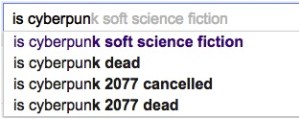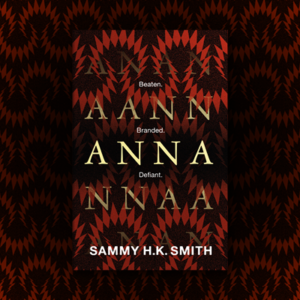
Any story which dips overly much into issues of society, culture, or what it means to be human, is often tagged as soft science fiction. Even cyberpunk, a high-tech genre, is usually considered soft, because of its thematic commentary on the fallen state of mankind.
The implication is that hard SF is somehow “better”, just as the hard sciences are “better”. Physics is a hard science. Psychology is not. Psychology is assumed to be flimsy, weak, inaccurate, and easy. “Soft.” Therefore, SF that deals with it is equally easy.
This division seems a little unfair, because to me the “soft” sciences are arguably far more complex than hard sciences. Physics and chemistry picked up the low-hanging fruit of empirical discovery, those aspects of our universe that could easily be discovered by looking through a microscope, telescope, or mass spectrometer. But understanding the interplay of synaptic pathways? That takes advanced tools like fMRIs and scanning electron microscopes, which have only recently been invented.
![Your brain is looking very, very closely at a brain.]](http://www.kittywumpus.net/blog/wp-content/uploads/2015/04/neuron-300x188.jpg)
All Freud and Jung had in 1900 was instinct and anecdote. So their research consisted of conjecture. Conjecture which has been built upon and advanced greatly since their time.
Access to technology is now blurring the line between soft and hard sciences. Soft SF concepts that used to require a certain amount of hand-waving can now be written about with a foundation in actual research.
It should follow that the line between soft and hard SF should also blur. And in many ways, this process has already occurred.
I remember reading my father’s shelf of classic authors, like Asimov, Heinlein, and Clarke (but also soft science-fictionist Bradbury). My young mind didn’t care that all the characters were cardboard cutouts, barely-human actors there only to convey the ideas. Because for me, the ideas were most important.
But mere ideas, as cool as they are, flicker over the surface of our minds, the frontal lobe of the neocortex. They fail to reach into the occluded recesses of emotion and subconscious. They fail to spark our deeper neurological wiring.
Some golden era stories did dabble in psychology, but they did so at a clinical distance. For example, the classic novel Foundation depicted a science called “psychohistory” ““ only at arm’s length. Psychohistory dispassionately crunched numbers to predict how people in masses move inevitably towards some end. But these stories weren’t really about the people themselves.
As I grew up, and as SF grew up, readers began to demand real characters. They wanted to see how the technology affected human beings. There was a realization that without people, science was meaningless, and the outer space we sought to explore would simply be an empty, darkened void.
Mainstream fiction has always focused on an exploration of humanity. The golden age of SF set itself apart as a genre by instead exploring ideas about the future. Since then, it has come back around to become a reflection of ourselves via an exploration of the future. The future has become ancillary to the purpose of SF.
A story that doesn’t mean something beyond the idea is not likely to be published. It’s not enough anymore to fire off dopamine in a reader’s neocortex. A story that doesn’t also evoke some emotion or spark some unknown “thing” in the hidden depths of our hearts is unlikely to be noticed.
Psychology and neuroscience has grown up, too. But we’ve never needed it to. Psychology is often discounted as “squishy,” but that’s because the mind itself is squishy. Many of Carl Jung’s insights 100 years ago still apply today. Modern science is simply discovering how the underlying cells and chemicals work to create the behaviors and mental dynamics he and his contemporaries observed.
And we’re discovering more parts of the mind than even Jung’s two-part consciousness vs. unconsciousness model suggested. An engineer or astrophysicist might prefer the simple, predictable mechanics of a one-brain, one-mind model, (hard science!), but to accept that would be in denial of the facts.
Many may be tempted to laugh at the hand-wavy woo of Jung’s “collective unconscious.” But is it really so silly now that we’re learning about how culture spreads and how about “memes” may be thought of as living creatures that reside in our minds and self-replicate to everyone who comes into contact with them?
Getting a bit meta here (because a mind exploring the mind is intrinsically meta), science fiction has always unconsciously acknowledged psychological principles. By way of example, dreams are a common fictional vehicle to represent thematic elements of a character’s past. This is classic Jungian psychology, and as authors and artists, we know the power of symbolic metaphor firsthand.
Yet how often do we address these ideas head-on, with self-awareness, making the reader aware of the processes of her own brain as she’s reading? Wouldn’t such stories act fully in the spirit of science fiction, which has always asked the reader to ponder her place in the universe, to ponder her own relationship to the ideas of the story?
It’s time to consciously embrace the mind sciences in science fiction. It’s our responsibility, because as a society, we will soon begin to feel the impact in our own lives. Science fiction needs to step up and fill its predictive role, both warning us and giving us hope. Warning us of the dangers of advancement, while simultaneously inspiring future engineers in how to apply the discoveries we’re making right now.
Because what could be more disruptive (both constructively and destructively) than a comprehensive understanding of the human mind? I’m not just talking about obvious technologies, like neural implants, but also developments in how we practice the art of existing in fully understood self-awareness. How might we structure society to account for a better understanding of what nature has already given us?
Moreover, in past-SF, we’ve treated the obvious tech (like neural implants) like toaster oven technology (nifty conveniences) ignoring the probable fact that these technologies will change us at our innermost core. Just as social media has transformed how we relate to one another, “upgrading” ourselves will transform what it means to be human.
And though these scenarios are difficult to imagine (because how else can we relate to our fiction except through our current understanding of humanity?), it’s our responsibility to close our eyes and imagine it. We need to grapple with these disruptions via fiction before the changes come.
Here are just a few questions we ought to explore:
- As we discover more neurotypes and cease to pathologize them, how will society change?
- What if we could all see a live map (fMRI-style) of our minds on our smartphones?
- Forget flying cars ““ how would the world be different if we could end the cycle of abuse, both in homes and in our public institutions? And how can we end those cycles of abuse? (Yes, this is science fiction!)
- How can we explore newly discovered aspects of the human brain by telling stories of alien beings that take those aspects to extremes?
- As we gain a better understanding of psycho-social manipulation, can we develop technologies (in the form of memes perhaps) that counter it?
Discoveries now tell us that the digestive tract literally is a mind of its own, and that the nerves throughout our bodies may play a much larger role in memory and thinking processes than previously thought. My words in this post may have triggered neurons in your left elbow. This point alone is worth a hundred science fiction stories.
And if that’s not hard SF, I’m not sure what really is.
Bio: Luna Lindsey lives in Bellevue, WA. Her first story (about a hippopotamus) crawled out of her head at age 4. After running out of things to say about hippopotami, she switched to sci-fi, fantasy, and horror. She also became an accidental expert on mind control, autism, computers, and faeries. Her stories have appeared in The Journal of Unlikely Entomology, Penumbra eMag, and Crossed Genres. She tweets like a bird @lunalindsey, intermittently blogs at www.lunalindsey.com, and publishes entire novels and nonfiction tomes at http://amazon.com/author/lunalindsey. Her novel, Emerald City Dreamer, is about faeries in Seattle and the women who hunt them.
#sfwapro
Want to write your own guest post? Here’s the guidelines.
Enjoy this writing advice and want more content like it? Check out the classes Cat gives via the Rambo Academy for Wayward Writers, which offers both on-demand and live online writing classes for fantasy and science fiction writers from Cat and other authors, including Ann Leckie, Seanan McGuire, Fran Wilde and other talents! All classes include three free slots.









 What fun! I really didn’t know what to expect when I accepted the Author of the Year recognition from the Baltimore Faerie Faire, but there was belly dancing, big bands, folk music, a hoard of really cool/fun people”¦
What fun! I really didn’t know what to expect when I accepted the Author of the Year recognition from the Baltimore Faerie Faire, but there was belly dancing, big bands, folk music, a hoard of really cool/fun people”¦ The Ball was great. Spritely music played as professional burlesque dancers, belly dancers, and folk dancers twirled on the floor. In between, the attendees boogied”¦ or is that bogied.
The Ball was great. Spritely music played as professional burlesque dancers, belly dancers, and folk dancers twirled on the floor. In between, the attendees boogied”¦ or is that bogied. Gershwin!
Gershwin! Author Bio:
Author Bio:
9 Responses
Cat Rambo: Guest Post from Luna Linsdsey: Putting the Mind Sciences in Science Fiction http://t.co/U165gOsPSJ
RT @Catrambo: Guest Post from Luna Linsdsey: Putting the Mind Sciences in Science Fiction: http://t.co/4Wb6UnOuNY
Guest post on @Catrambo’s blog: Putting the Mind Sciences in Science Fiction. http://t.co/igBQIhYi5a #SciFi #Psychology #neurodiversity
ICYMI, my guest post on @Catrambo’s blog: Putting the Mind Sciences into Science Fiction. http://t.co/igBQIhYi5a #Psychology #SFF #WriteTip
RT @lunalindsey: ICYMI, my guest post on @Catrambo’s blog: Putting the Mind Sciences into Science Fiction. http://t.co/igBQIhYi5a #Psycholo”¦
RT @lunalindsey: ICYMI, my guest post on @Catrambo’s blog: Putting the Mind Sciences into Science Fiction. http://t.co/igBQIhYi5a #Psycholo”¦
RT @lunalindsey: ICYMI, my guest post on @Catrambo’s blog: Putting the Mind Sciences into Science Fiction. http://t.co/igBQIhYi5a #Psycholo”¦
RT @lunalindsey: ICYMI, my guest post on @Catrambo’s blog: Putting the Mind Sciences into Science Fiction. http://t.co/igBQIhYi5a #Psycholo”¦
RT @lunalindsey: ICYMI, my guest post on @Catrambo’s blog: Putting the Mind Sciences into Science Fiction. http://t.co/igBQIhYi5a #Psycholo”¦